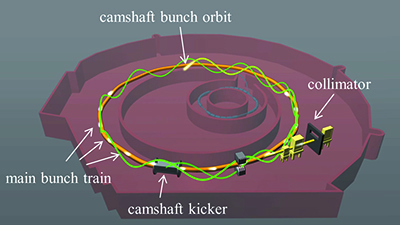On-demand X-rays at synchrotron light sources
 Consumers are now in the era of "on-demand" entertainment, in which they have access to the books, music and movies they want thanks to the internet. Likewise, scientists who use synchrotron light sources are welcoming an era of “on-demand” X-rays, in which they have access to the light beams they want thanks to a technique developed at the U.S. Department of Energy (DOE)’s Lawrence Berkeley National Laboratory (Berkeley Lab).
Consumers are now in the era of "on-demand" entertainment, in which they have access to the books, music and movies they want thanks to the internet. Likewise, scientists who use synchrotron light sources are welcoming an era of “on-demand” X-rays, in which they have access to the light beams they want thanks to a technique developed at the U.S. Department of Energy (DOE)’s Lawrence Berkeley National Laboratory (Berkeley Lab).
Working at Berkeley Lab’s Advanced Light Source (ALS), a DOE Office of Science User Facility, researchers have created an operational mode for synchrotron light sources that provides full control of the timing and repetition rate of single X-ray pulses without affecting beams for other users [Hertlein et al. (2015). J. Synchrotron Rad. 22, 729-735; doi:10.1107/S1600577515001770]. The mode, which is called "pseudo-single-bunch kick-and-cancel", or PSB-KAC for short, works by displacing and routing a single electron bunch – dubbed the "camshaft bunch" – from the multi-bunch train of an electron beam in a synchrotron storage ring so that only X-ray light from this camshaft bunch reaches the experiment.
"With PSB-KAC, synchrotron light source users conducting stroboscopic experiments have full control over which of the X-ray pulses will arrive at their sample out of a pulse train that usually arrives at a fixed frequency of 500 megahertz", says ALS beamline scientist Andreas Scholl. "PSB-KAC allows users to do timed experiments in which the X-ray pulses must be synchronized to a laser, detector, or some other device during normal light source operations because the X-ray pulse pattern can be dynamically controlled for their individual experiment."
Says David Robin, the ALS division deputy for Accelerator Operations and Development, "The on-demand X-rays provided by PSB-KAC greatly reduces radiation damage to samples while improving signal-to-noise and background ratios for sensitive measurements. Until now, the X-ray pulse train in synchrotron light sources has been static and limited by the design and operation of the storage ring. With PSB-KAC, synchrotron light source users can optimize their experimental set-up for single shot, kilo- or mega-hertz repetition rate pulses."
PSB-KAC has been in use at the ALS for nearly a year and the response by users has been enthusiastic. Robin says the technique is applicable to other existing synchrotron light sources and should be advantageous for future light sources as well.
"We have demonstrated the use of PSB-KAC at the ALS in pump–probe measurements on spin crossover complexes, and in a warm dense matter demonstration experiment using a time-integrating single-shot streak camera", Robin says. "I would not be surprised if other synchrotron light source facilities, including next generation storage rings, begin PSB-KAC operations in the near future."
This article is reprinted from material taken from Lawrence Berkeley National Laboratory, with editorial changes made by IUCr.

